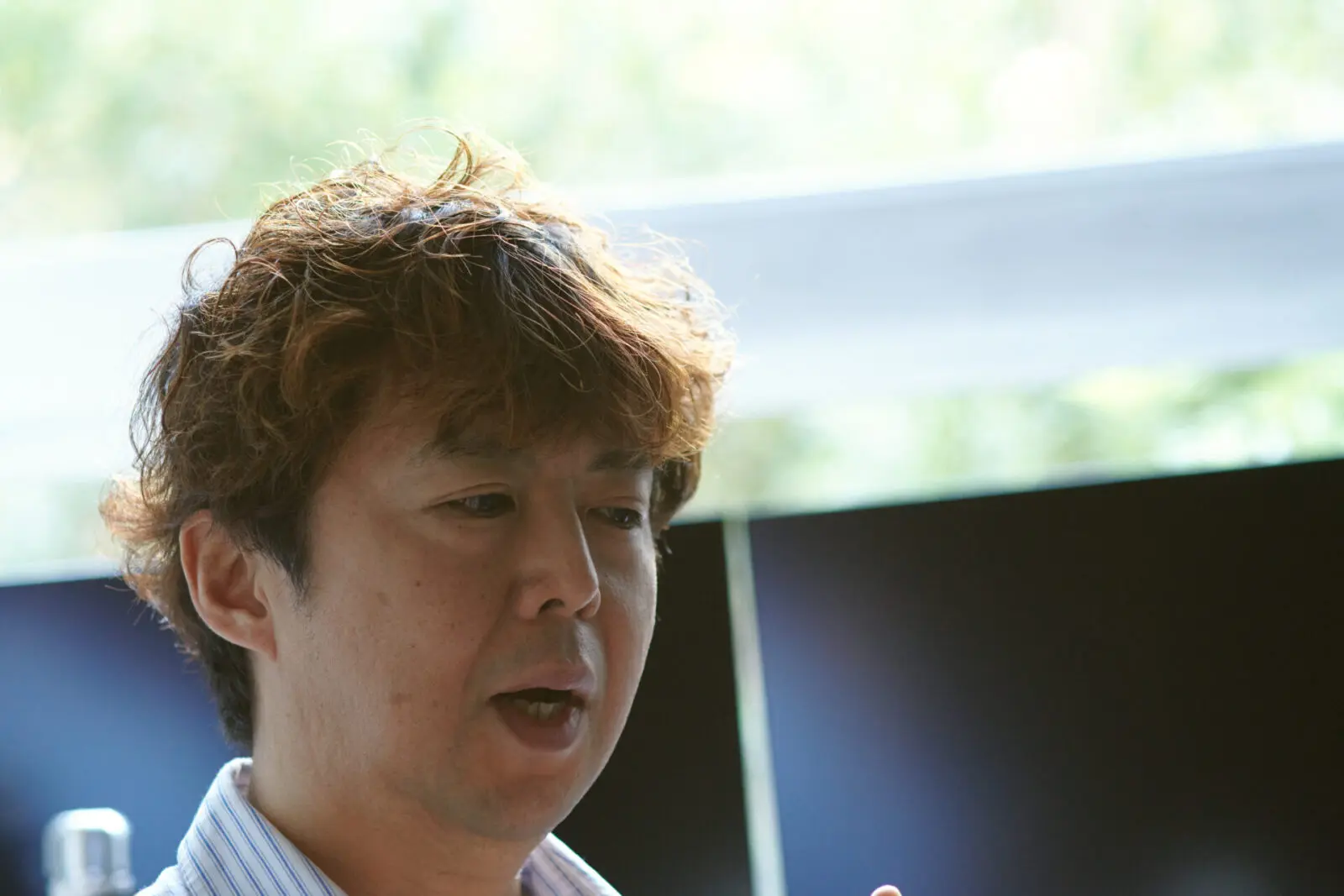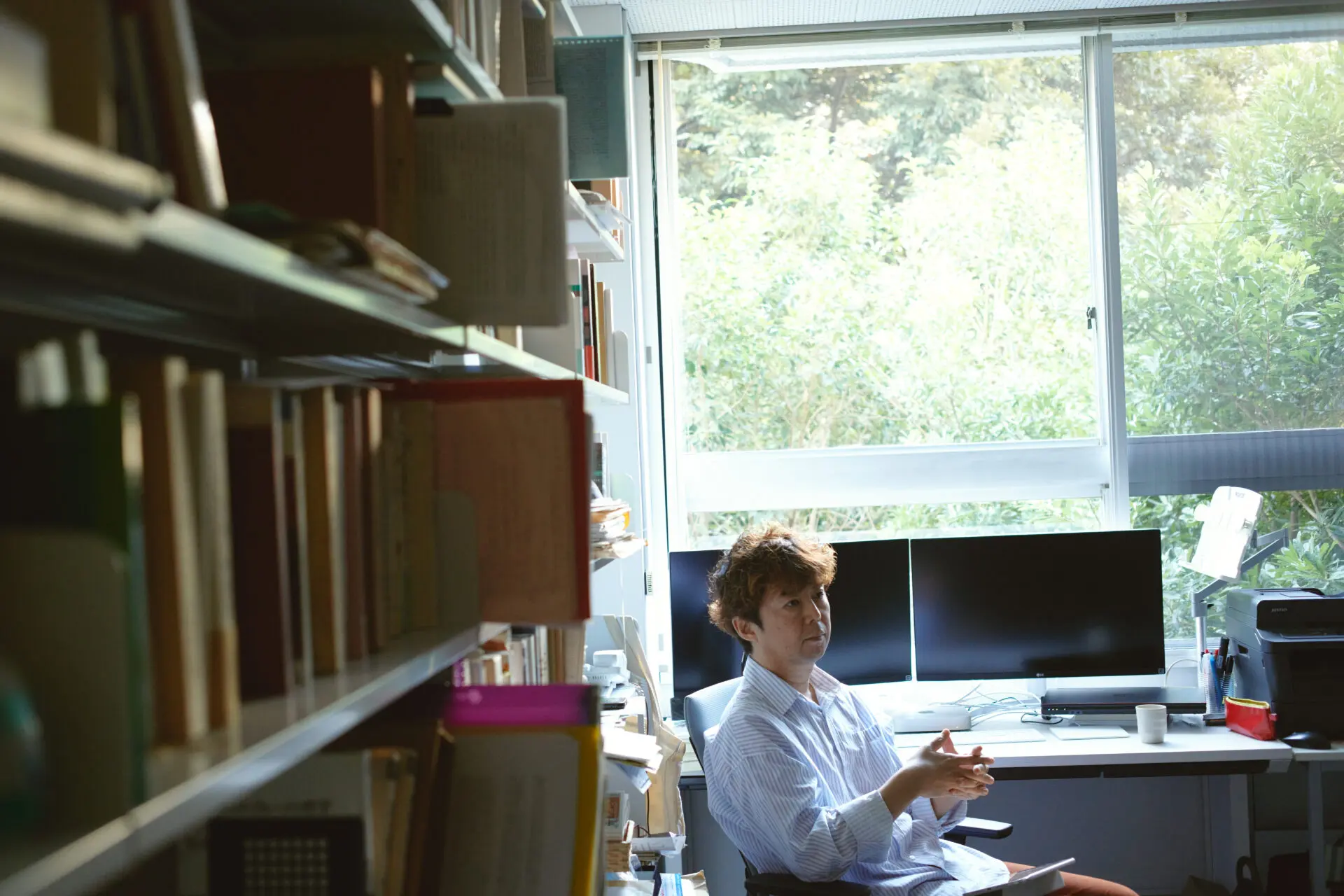Whether we enjoy making a cup of tea, brewing coffee, or smoking a cigarette, the nature of our shikohin experiences vary. However, no matter the experience they are all special moments in time.
To elaborate further, our lives are all inextricably linked to time.
The book Made Out of Time – An Invitation to Bergson’s Philosophy of Time (『世界は時間でできている──ベルクソン時間哲学入門』) published Seidosha in July 2022, explores the relationship between our mind and time through Henri Bergson’s (a French philosopher of the late 19th to early 20th century) philosophy of time.
The author of the book is Yasushi Hirai, a professor in the Faculty of Letters at Keio University who specializes in the philosophy of the mind and time, the metaphysics of memory, and modern philosophy with a focus on Henri Bergson and Gottfried Wilhelm Leibniz.
We visited Hirai to discuss what significance the time we spend enjoying shikohin has on our mind and spirit. In Part 1 of this article, we will first explore the philosophical question of the fundamental meaning of time.
To paraphrase the title of Hirai’s book, “We are made of time”.
(聞き手・文:鷲尾諒太郎 写真:今井駿介 編集:小池真幸)
The world is made of time and memories
—— You specialize in the philosophy of time and mind, the metaphysics of memory and modern and contemporary philosophy with a focus on Bergson and Leibniz. What is the focus of your studies at the current moment?
Recently I have been exploring the philosophy of memory as an approach to the question of the philosophy of time.
What significance does memory have on our views of humanity and the world? I feel that this discussion is not valued enough in the world of philosophy and I am working on changing that.

When we hear the word “memory” many of us intuitively think of episodic memories or memories of everyday events such as something that happened a few years back or what someone said in the past. However, that is only a part of what memory is.
In fact, memory is a much broader concept and the function of memory is instilled in us in every way.
For example, you can see the many things in front of us at this very moment. The fact that we can see all of these things here is part of memory. In other words, if a newborn baby was here, what the baby sees will not be the same as what we see.
From the moment we are born we develop the ability to see things three dimensionally and identify colors through the process of repeated learning. We are born not with established perception, i.e. the ability to see and hear things like adults, but it is something we gain through learning and memorization after birth.
If we think of humans by dividing the mind and body, it is not only the mind that has or develops memory. Our body and its movements are also developed through memory.
For example, the reason we are able to walk, run or ride a bike is because we learned how to do so when we were little. We forget about the fact that we learned such things because it is in the distant past, but no one is able to do these things from the moment they are born.
Then there is also knowledge. The knowledge we obtain through study and learning in school or at work is called semantic memory. The act of thinking and reasoning would not be possible without this memory.
Furthermore, it is known that our judgment is influenced by things that we have seen or heard in the previous moments. Its effects last for a long period of time. It is a memory phenomenon called “priming” and although we are not conscious of it at all, its effects are proved through experimental studies.
In many fields of study, including philosophy, we often divide the study of “perception”, “body” and “knowledge” into different categories, but if you introduce the category of “memory”, everything else becomes a sub-category of memory.
Our actions, perceptions, and thoughts are all in fact different manifestations of memory. This may be an effective way to look at holistic phenomena in a comprehensive way.
And that is one reason why I focus my studies on memory.
—— You could say that the world is made up of memories.

Bergson’s most famous book, Matter and Memory, also talks about the deep relationship between memory and time.
The time that a person lives is accumulated and stored in the body and that makes up who that person is in the present moment.
Accumulated time is time that we may not recall, much like how we do not remember how we first learned how to walk. However, it is time that has certainly accumulated in our bodies.
On the other hand, there are also past times that shine inside us like a shining star that we are able to recall anytime. We all have such memories inside us.
As I mentioned earlier, perceptions, actions and thoughts are made up of the intertwining of memories that manifest itself in different ways. Memory is what connects the past to the present.
We can say that humans are made up by the truly complex interweaving of time.
We live through accumulating and expanding time and that is what makes us who we are today.
Time and memory are very important for our existence.
There is no “absolute” in time
—— Time has been an important topic in philosophy for a long time. What were the characteristics of Bergson’s theory of time that made them so innovative?
Even Aristotle spoke on the theme of time and it has continued to be an important theme in philosophy to this day.
However, Bergson introduced a number of ideas that radically changed the debate on time in the field of philosophy. Three of his ideas were particularly important.

The first is the multiple time scale.
Before Bergson, time in philosophy was understood to be absolute and exact. Based on this idea, questions such as the existence of time, the existence of the past and whether time is flowing were explored. In technical terms, the debate was based on a singular idea of absolute time.
However, Bergson argued that absolute time does not exist.
He stated that there are many different scales of time, both large and small, that exist in the universe.
He also believed that there are multiple different scales of time that exist inside each one of us.
—— What did he mean by multiple scales of time inside each of us?
For example, I am sitting here talking to you right now while thinking about what I should say next. At this moment I am thinking on a second by second scale.
At the same time, although I may not be thinking about it deeply at this moment, in the corner of my mind I may be thinking about my long time partner or friend, or a project that may take several years to complete. These thoughts are on a year by year scale.
In this way, there are various scales of time that simultaneously exist in our minds and all of these times shape who we are. Bergson proposed the diversity of scales in time and rejected the conventional view of absolute time of that era.

The significance of understanding time as “aspect”
—— Please tell us the second of the three innovative ideas that Bergson came up with.
The second idea that I am particularly focused on in my research is the idea of “aspect”.
—— What does he mean by aspect in philosophical terms?
Let me start by explaining that time is understood as having two faces which are quantity and quality.
Quality is the property of time that can be measured by a certain unit, such as by a clock, calendar or stopwatch.
However, time is not only a quantity. How do we understand the quality aspect of time?
Before Bergson, many philosophers argued the existence of past, present and future tense. Indeed, the past, present and future tense cannot be expressed in quantitative terms such as “minutes” and “seconds”.
Concepts such as the “irreplaceable past” or the “specialness of the present” cannot be expressed by a clock or calendar.
Philosophers of the past were frustrated by this and looked at the past, present and future tenses as “quality” of time rather than “quantity” and argued how quality influences mankind. Augustine (of the Roman Empire) is a prime example of such a philosopher.
Bergson introduced “aspect” as a new way of looking at the quality of time. It became a third angle of looking at the concept of time.

Aspect refers to the internal structure of a given time. Bergson said that time has “perfect” and “imperfect” aspects.
Just as the name implies, the perfect aspect is time that has passed and has been completed. It can also be explained as a static, where the outcome is known. On the other hand, uncompleted aspect is the time that refers to things that have not yet ended. It is dynamic and we do not know what will happen next.
To express the difference between “perfect” and “imperfect” aspects in simpler terms, time can be likened to having a completed tense and an ongoing tense. However, it is important to note that this aspect is completely different from the past, present and future tenses we mentioned earlier.
—— I think that “perfect” and the “past” are somewhat similar, but what is it that makes “aspect” different from past, present and future tense?
It is easier to understand the difference when you think of something that is in the future but a completed aspect, or something that is in the past but is an uncompleted aspect.
For example, when we talk about a lunar eclipse that will occur in the future and the outcome is already certain because we know what date and time it will happen. This is a completed aspect.
On the other hand, suppose you remember an embarrassing experience from the past and blush. If you can recall the experience without getting embarrassed it would be a completed aspect, but if you still blush from embarrassment it is an uncompleted aspect.
Although that experience happened in the past, it is still ongoing and therefore still influences our lives as an uncompleted aspect.
This is what Bergson focused on.
Aspect, past, present and future tenses are all independent of each other. In reference to this, we can say that tense and aspect are orthogonal to each other. There are cases where time is both past and uncompleted and cases where time is present but completed.
── So there are things we recall from the past that is still dynamic because we do not yet know what it will lead to next, and then there are things that are happening in the present that are static because we already know what is going to happen.

Yes. Let me explain with another example. I had kebab for lunch today.
If you ask what the difference between “I am eating a kebab” and “I ate a kebab” is, many people will say that it is the difference between the past and the present.
We are accustomed to perceiving time in a singular line, so when we are identifying “I am eating a kebab” on a line, it falls in the “present” position. At the same time, “I ate a kebab” will be placed in the “past” position.
Looking at this from the perspective of aspect, the difference between “eating” and “eaten” is the difference between a completed and uncompleted aspect.
It can be said that the difference is in whether what will happen has been determined or not.
For example, if you are eating a kebab right now while already knowing what it tastes like, what is in it and what to expect from it, this is a completed aspect.
Or, if you are eating in a hurry because you are expecting guests to arrive, it is not really “time spent on eating”, but time in the midst of a completed aspect. These aspects are not about the quantity of time, but more about the quality of time and that is why it is different from time that is placed on a time axis (tense).
When we plot time on a single line, we misjudge it
── To summarize, time has past, present and future tenses while also having completed and uncompleted aspects.
There are always things in our lives that are in the uncomplete aspect. These are exciting and unpredictable and many people are aware of its existence as it shows up in our lives from time to time.
However, people often try to predict what will happen based on past experiences and will take these rambunctious existences of time and try to force it into a mold. We try to manage time in this way.
Bergson called this “superimposing spatial concepts in time”. Although this may be a necessary evil in order for us to live our lives, when we talk about the philosophy of time it is important to be critical of it.
In our modern world today, I think it is becoming increasingly difficult to live in an uncompleted aspect of time.

── Do you think we try to gain a sense of control through covering up the unpredictable and unstable “uncompleted” aspect of time with quantitative (measurable) time and tense?
I think so. In order to explain the unpredictability of time Bergson used the term “interpenetration”. He said that moments interpenetrate.
We think that one second is followed by two, three, four and so on. However when we think of time in this way, we are perceiving it as on a singular line.
The meaning of interpenetration is that there is no before or after in the current moment. For example, I sit here speaking in this moment, and there is no time before or after but this moment is consistently replacing itself.
── Can you elaborate on the concept of interpenetration?
Perhaps it is easier to understand if you think of what came before as permeating into what comes after. The impression we get on words and melodies change and are influenced by the words and melodies that come before it.
The interesting thing about interpenetration is that the reverse is also true. The things that come after also influence the things that came before. This may seem hard to grasp at first, but it is in fact a very important point.
In modern studies of cognitive science this concept is referred to as “postdiction”.
Postdiction means “the influence of a stimuli obtained after an (absolute) time that affects the perception of stimuli that occurred before.”
Experiments using visual and tactile stimuli have confirmed that the perception of the immediately preceding object can be changed by the influence of (objectively) later stimuli within a very short period of time.
Another example is that people do “lip syncing”, which is when they match the sound of voices that come later with the movement of the lips that reaches their consciousness before. The voices of people far away reach us later than the images. This means that our minds are making the images “wait” for the sounds to come.
In other words, in our everyday lives we are unconsciously moving time back and forth and proactively creating time as we move along.
With this, you can see how we are constantly living in an uncompleted aspect of time in which we do not know what will happen next
The moment we plot time on a singular line, we convert time into a completed aspect. This act prevents us from ever capturing uncompleted time, or the real time in which we are actually living.

── I feel that this concept of aspect has greatly changed the way I understand time. Please tell us about the third of Bergson’s innovative ideas.
The third idea that Bergson introduced is the idea of an axis of tension and relaxation in time.
This may be easy to understand if you think about it intuitively. It is the idea that time can be tightened (tension) or loosened (relaxation).
Before Bergson introduced this idea, time was generally understood as having a horizontal axis that represented “passage” of time. In this axis, he introduced the idea of tension and relaxation. This is another example of Bergson’s unique way of thinking and an important theme to study.
── I agree that the idea of tension and relaxation in time is easy to grasp intuitively. I think this idea leads us to our next theme of “time with shikohin”.
To be continued in Part 2
[前編・了]
